
During the Pearl Harbor raid that opened the Pacific War – perhaps the world’s first energy war [1] – Hickam Army Air Force base was among the initial targets attacked by Japanese fighters and dive-bombers.
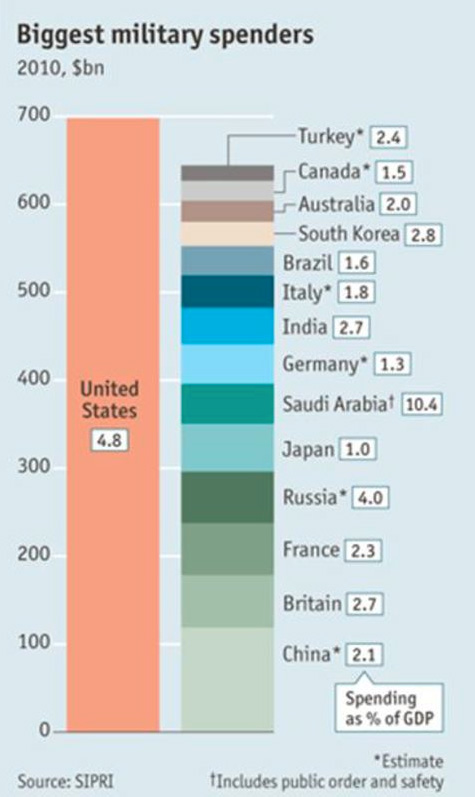
After outlining this programme and its implications, I shall argue that Japan in particular should take note. But I shall also conclude that we should all be more cognizant of what the US military is doing, and why it is trying to build sustainability. When the military is trying to go green in the face of opposition in Congress and much indifference in civil society, you know there is a very grave problem.
The Energy-Environmental Revolution
As we enter yet another downturn in the protracted Great Global Recession, the major sustainable recovery opportunity for Japan, the US and other countries is in the energy sector and related infrastructure. [9] Energy is the world’s largest sector, at least 10% of the global economy, and dominated by the conventional energy plied by Sinopec, Exxon, Gazprom and other behemoths battling to hold their turf and enlarge it. [10] Energy has the potential to be the core of a sustainable recovery not merely because it is the world’s largest industry and in the midst of a disruptive revolution. It is also the world’s most damaging industry via direct health costs [11] as well as being the source of the vast majority of anthropogenic greenhouse gas emissions that are the heart of global warming. [12] The sector includes a burgeoning and disruptive renewable energy component [13] as well as the increasingly large jobs and sustainable growth potential from conservation and energy efficiency, often called the fifth fuel. [14]
Energy is not just big; it is also a byzantine business. It involves liquid fuel, gases, burnable solids such as coal and the like, and nuclear power. Such are the enormous volumes of stuff dug up, moved around, and burnt that, in 2011, the world consumed about 7.7 billion tonnes of coal and 32 billion barrels of oil. Perhaps more staggering yet is this metric: total global energy consumption in 2006 was roughly 16 terawatts, or about half to one-third of the total heat flow from this planet’s interior. [15] Before it found itself dragged into seemingly endless and undeniably expensive wars for oil, the US military used to take access to cheap and plentiful conventional energy even more for granted than the civilian economy. [16]
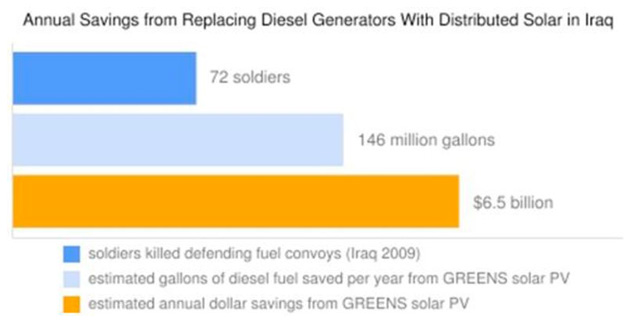
The military has a broad array of powerful incentives to lead the United States out of dependence on conventional energy, through the deliberate and creative destruction that is embedded in the new institutions of green industrial policy. The pillar of the military’s numerous macro-level, strategic incentives is the fact that the US accounts for about half of total global military spending. [17] This enormous scale gives it the strategic position from which to perceive as well as act on energy and climate threats.
No other country’s military combines the scale and the global reach of America’s. The US military patrols the major sea-lanes and effectively guards most of the key pipelines through which vast flow quantities of conventional energy. It has enormous power, unparalleled in absolute as well as comparative terms, but it is tethered to these fuels and their physical infrastructures.[18] And it confronts, in China, a competitor increasingly reliant on rapidly swelling imports of those same fuels. China is thus concerned to expand its access to conventional energy as well as guard the sea-lanes it depends on to bring them home.
China’s unfolding and unnerving standoff with Japan (and thus the latter’s ally America) over the Senkaku/Diaoyu Islands expresses at once all of the mounting perils implicit in the ties that bind us to unsustainable energy. The islands are not only critical to claiming ownership of presumed vast gas and oil resources far below the surrounding seabed. They are also important for Chinese submarines’ unobserved movement into what is rapidly becoming the world’s most strategic waters. [19]
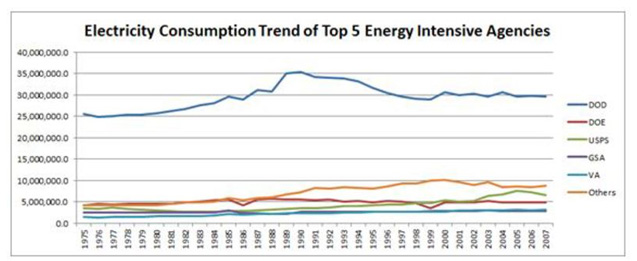
At the same time as the tether of conventional energy pulls it into desperate straits, the US military’s global role also means it is called upon to intervene in conflicts or emergencies related to crises driven by climate change and its increasing intersection with the critical water-food-energy nexus. [20] Because of these and other sobering strategic facts, the US military’s 2010 Quadrennial Defense Review describes climate change as a “threat multiplier” and renewable energy and energy efficiency as “force multipliers.”
Let us turn to a few of the multiple meso and micro-level factors motivating the US military’s activism. Among other grim realities is the fact that it consumes more energy than any other institution on the planet. Indeed, the military consumes 80% of all energy used by the US federal government and “more energy than is consumed by two-thirds of all the nations on Earth.” [21] The military is also highly dependent – tethered in quantifiable human costs – on liquid fuels for its logistical supply lines. It is also quite sensitive to conventional energy prices that undermine its fiscal planning.

Moreover, the military is obligated to act on renewables and efficiency. Congressional and White House mandates require federal agencies, including the military, to adopt renewable energy as well as increase their efficiency. The “Energy Policy Act of 2005” compels federal agencies to obtain at least 3% of their energy from renewable sources by 2009 and 7.5% by 2013. And note that George Bush’s White House promulgated Executive Order 13423, obligating federal agencies to reduce their energy intensity by 3% annually to 2015 relative to the 2003 base year. [22]
The military has taken these targets and run with them. Its commitments to renewable energy include the Navy’s goal of 50% renewables by 2020, and the overall Department of Defence aim of 25% by 2025. It is also helping to diffuse sustainable energy through its partner militaries. [23] It is quite deliberately not opting to purchase the mini-nukes and other conventional forms of energy that are pressed on it by their respective industries and their representatives in Congress. It has also not bought into the irrational exuberance of the “golden age of gas” at present stirring up dreams of cornucopia in America and elsewhere. The military is also a key actor in developing sustainable biofuels as well as exploiting waste-to-energy, landfill gas and other hitherto largely ignored resources and potentials. It has also become central to driving energy efficiency forward, which may turn out to be the most critical fact of our time. [24] The military is using its facilities as test sites for innovations in extremely high efficiency air conditioning, electrochemically super-efficient smart glass, geothermal heat pumps, and other kinds of means for drastically reducing the energy footprint of facilities. The military wants predictability, sustainability and security in energy, and has concluded that renewable and efficiency are key to achieving these objectives.
The Institutional Nexus
Many of the military initiatives referred to in the above have already been brought up by the mainstream media in the United States and elsewhere (though incredibly not in Japan). The details are hardly a regular item in the news, of course. Yet it is at least no longer a surprise to find an article on the US Navy’s goal to source 50% of its energy needs from renewables by 2020. [25] One part of the Navy’s ambitious programme, the sustainable biofuel initiative, was in fact impossible to ignore in the middle of 2012. Over several months, the Navy and much of Congress (especially Republican Senators Jim Inhofe [26] and John McCain) clashed over the purchase of sustainable biofuels, including algal-based biofuel. [27] But the Navy’s biofuels initiative survived the challenge from forces wedded to the unsustainable status quo. And hence did the Navy’s plan to put to sea, in 2016, a “Great Green Fleet” powered by sustainable biofuels. [28] Though rightly cautious not to seem pro-military, progressive observers are coming to grasp the significance of the military’s fight with vested energy interests. [29]
What continues to go unreported and unexamined is the institutional nexus that animates the US military’s energy and climate initiatives. Most media of course have almost zero tolerance for that sort of detailed content. But even quite recent studies by, for example, the US Government Accountability Office, [30] continue to discuss the military and its targets in isolation. The GAO – as well as RAND and a host of other agencies – writes on the costs and related aspects of the military and renewables without describing the larger organizational context for those initiatives and the already quite elaborate programme for diffusing their fruits.
Indeed, nearly all work on American alternative-energy efforts has tended to focus on federal tax credits, state-level RPS, and other disparate details as opposed to the enormous institutional elephant expanding in the room. [31] In consequence, we have no overview describing how the US military is not working on its own, but rather operates within the increasingly close embrace of the world’s most advanced energy/efficiency R&D cluster. The world’s largest military is greening in the midst of the world’s largest federal public sector (about 24% of USD 16 trillion GDP), and we have no serious analyses of the economic implications, including price destruction and scalability, of the programme. Nor do we have a political discourse on the implications of this military-centred development, deployment and broad diffusion of green tech inside the larger federal government and beyond. In short, profound changes in the US energy regime are advancing beneath the radar.
Look beyond the emergent fascination with the greening of the military itself. Not surprisingly, one sees a very large and expanding constellation of advanced research centres and firms, working with the military on SPIDERS and related projects.
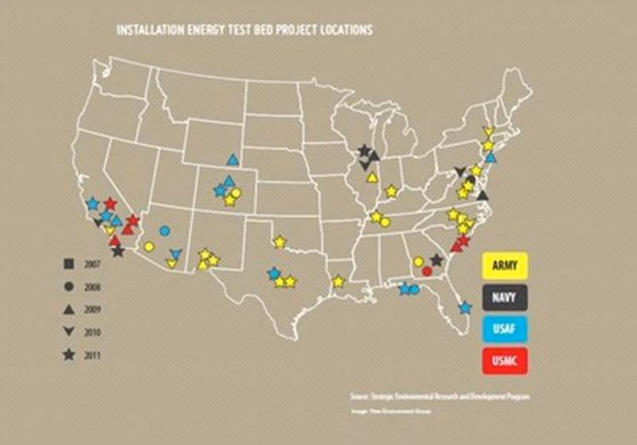
These research centres include the National Renewable Energy Laboratory, Sandia Laboratories, and other elements of the world’s most advanced scientific-technological complex for research on renewable energy, efficiency and conservation. Other elements of this densely networked cluster of interests working with the American military include the justly famous Rocky Mountain Institute headed by Amory Lovins. Lovins, is one of the most articulate advocates of energy efficiency and a renewable energy transition. Perhaps less well known is that he has also long been advising the American military on how to increase its efficiency. Another important actor in a long list is the American Council on Renewable Energy (ACORE). ACORE is a key non-governmental agency coordinating the close interaction between green business and the military.
But the heart of this constellation appears to be very purposive and coordinated collaboration among the DOD and the General Services Administration (GSA) as well as the Departments of Agriculture (DOA), of Energy (DOE), the Interior (DOI), Homeland Security and such agencies as the Environmental Protection Agency (EPA). Even in an era of “small government” and the so-called “fiscal cliff,” these institutions have significant spending power, regulatory authority, and enormous physical presence. Moreover, the collaboration within the US federal government is not limited to this list, and extends as well to the intergovernmental dimension. [32]
But look more closely, and it is clear that the DOD and the DOE are the most strategic actors among the federal agencies. The two continue to evolve a Memorandum of Understanding in which DOD facilities act as test-beds for technological developments emerging from such sites of innovation as Advanced Research Projects-Energy (ARPA-E) in the DOE.
The ARPA-E is worth an even closer look, because it appears to be just coming into its stride. ARPA-E follows on the famous Defense Advanced Research Projects (DARPA) initiative that started in 1958, in response to the perceived Sputnik challenge from the then-Soviet Union.[33] Using the DOD’s massive purchasing power, DARPA-led research bore such fruit as stealth aircraft, the global positioning system, and the internet. The 2007 creation of ARPA-E saw realization of the US scientific elite’s recommendation for an energy agency to address the concern that the country was being left behind on clean energy. ARPA-E is part of the DOE and got its first budget from the Obama stimulus, or American Recovery and Reinvestment Act. [34]

Being part of DOE, ARPA-E lacks direct access to DOD’s ability to create markets that carry innovation beyond the so-called “valley of death,” where lack of finance often sees innovations go unrealized in the form of prototypes for engineers to tinker with. [35] That institutional fact, of ARPA-E’s separation from big spending power, is very important because it appears to have facilitated collaboration between DOD and DOE via the Strategic Environmental Research and Development Program, or SERDP. This agency was put in place in 1990 to address DOD’s considerable environmental issues. SERDP is co-managed by the DOE and the EPA along with DOD. The SERDP therefore brings together these three key institutions, via its research agenda and the work of managing the projects that ensue from its research. As a matter of fact, this collaboration is written into SERDP’s organizational DNA: its own introductory literature argues that “Designed to address issues common across all of the Armed Services and DOE, the Program [ie, SERDP] is a catalyst for cooperation and collaboration.” [36]
Another core agency helping to facilitate this broad collaboration is the DOD’s “Environmental Security Technology Certification Program, or ESTCP, whose Director also heads SERDP. ESTCP is DOD’s environmental technology demonstration and validation program, established in 1995 “to promote the transfer of innovative technologies that have successfully established proof of concept to field or production use.” [37]
These agencies and their collaboration is a crucial fact worth dwelling on, even to the point of pedantry. One major reason is that their collaboration has clearly fostered critical thinking on leveraging organizational assets. Public-sector institutions have scale and heft, and thus much potential, but getting them to confront new problems and lead productive change is always a challenge. The fact that ARPA-E is new and the climate-energy crisis so undeniably vast, and increasingly immediate, appears to have helped concentrate minds. Working together, this gathering of familiar as well as obscure acronyms has crafted a strategic programme for development and deployment of renewables and efficiency throughout the military. Using the military’s vast “land and demand,” they continue to innovate mechanisms to entice private capital into making investments in solar, wind, biomass and other generation capacity. Among the innovations is the new fact that only the military has the capacity to make 30-year power purchase agreements. [38] These engineers of change also use the fact that the US Army possesses the world’s biggest vehicle fleet (at over 82,000 non-tactical vehicles), to encourage participation in technological development. But they have gone further than this. They use their purchasing power, including the option to lease and thus take advantage of rapid technological advances, to encourage even more petroleum cuts than say the army’s 28.5% over the past two years. [39]
As the SERDP points out, the DOD has “300,000 buildings and 2.2 billion square feet of space?three times the footprint of Wal-Mart and five times that of the General Services Administration.” The DOD spends USD 4 billion a year on energy on air-conditioning, lighting, and otherwise managing all these structures. Using that massive draw on resources as the equivalent of a market, the SERDP has a programme in place to deploy not merely the SPIDERS microgrids but also advanced renewable energy and efficiency gear. The latter include smart glass and a range of other projects that at the very least rival, and generally far outclass, anything seen in smart-city developments going on worldwide. [40]
And the GSA bills itself as “one of the nation’s largest landlords…[being the] owner or lessor of more than 9,600 buildings nationwide, encompassing 370 million square feet and housing about 1.1 million federal employees.” In collaboration with DOD and NASA, the GSA is stressing the diffusion of efficiency through the building stock it maintains. [41]
Moreover, the SERDP’s evolving relationship with ARPA-E is a crucial part of even better and faster coordination, according to Jeff Marqusee, director of both SERDP and ESTCP. In a recent interview, Marqusee expresses the hope that closer DOD and DOE collaboration will accelerate technical advance and help the “private sector hand-off happen more rapidly.” Marqusee adds that the DOD has already made good use of ESTCP’s Installation Energy Test Bed, a strategy adopted in 2009, “to deploy and evaluate several high-value energy projects to accelerate commercialization.” [42]
The Implications
The point of this discussion is not to applaud the US military. It is certainly better from the perspective of global emissions, however, that the US military is stressing energy efficiency and renewable energy rather than deploying as much natural gas, oil, nuclear and other forms of conventional energy as possible. At the same time, the global operations of the American military are extremely destructive in their impact on people, land and the environment…for example, in defoliating much of the forest cover of Vietnam as well as inviting blowback from the Middle East and North Africa by outraging local populations with the constant threat of drone and other attacks.
But when it comes to grasping the existential crises we confront in energy and climate, the military have no vested corporate interests to coddle and no faith-based, ideological predispositions to shield from the facts. Their analysts thus apply a sharp and unbiased perspective, far more critical than the hopelessly compromised IEA whose reports on energy are the basis for most governments’ energy policymaking. [43] And contrast all of that, even the IEA’s contradictions, with most of the global public debate about energy options and climate change and their already grave implications. The willingness to play with fire is strikingly reminiscent of the disastrously complacent mind-set that, until the Lehmann Shock, dominated Alan Greenspan’s FRB, the Bank of International Settlements and most of the rest of the world concerning derivatives and systemic risk. [44]
And thus the disturbingly ironic reality that, while civil society is largely AWOL, one of the bright spots of our era is that the US military is the core of an energy-industrial policy apparatus. We have seen that the apparatus has evolved over the last decade and a half and is now profoundly influencing the American and world political economy. Consider that the micro-grid tested at Hickam air base represents just one signal development in an ongoing shift from centralized and conventional to decentralized and renewable power. This was not a limited test, as “over 40 DOD military bases either have currently operating microgrids, planned microgrids, or have conducted studies or demonstrations of microgrid technologies. DOD also has 600 forward operating bases (FOBs) and is investigating the deployment of even smaller mobile, tactical microgrids in Afghanistan and other engagement hot spots.” [45]
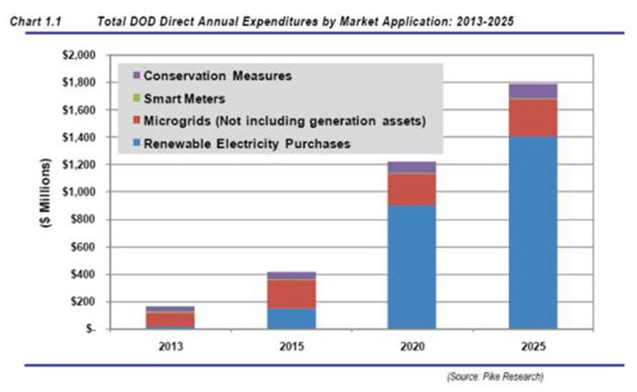
It is no exaggeration to say that we see in military microgrids just one of the multiple spearpoints leading a larger transformation that is already underway. In the US, the chair of the American Federal Energy Regulatory Commission (FERC) Jon Wellinghof has indicated this and the FERC has followed up with regulatory changes to accelerate distributed power. [46] Indeed, data from the FERC’s “Energy Infrastructure Update” tells that in 2012, renewable power accounted for just about half of all new power installation in the United States. [47] Distributed, renewable energy is also the focus of a steadily increasing number of studies and investigations that, among other things, indicate it is essential to sustainability. [48] And a vast array of utilities, financial institutions, power-unit makers (such as GE) and other institutions and businesses are seeking to position themselves to benefit from this ongoing and quickening transformation of energy regimes. [49] The green initiatives and their deployment in the military and beyond thus have enormous potential to maintain a profound pace of innovation in this transformation.
It is of course not only the Japanese who should be taking note of this ongoing revolution centered on the energy industrial policy nexus in the United States. Still, two years after the Fukushima Shock, Japan should be astonishing us all with miracles in efficiency, conservation and renewable energy. But there is as yet no miracle emerging from Fukushima, save perhaps for the political rebirth of Abe Shinzo as PM aimed at recovering as much as possible of the pre-Fukushima status quo.
Considering Hickam’s history and the energy desperation that led Japan to attack Pearl Harbor, as well as current Japanese energy shortages and choices, one would think that the Japanese would closely follow America’s larger energy-industrial policy enterprise. That point is particularly true of SPIDERS and the other military energy-environmental industrial initiatives in Hawaii, whose second-biggest source of employment is the US military. [50] After all, Japan not only attacked Pearl Harbor in order to gain access to energy, but is now billed as the “unsinkable aircraft carrier” for American military force projection. Japan also holds, so to speak, the patent on industrial policy and – on top of all that – tends to think of Hawaii as more Japanese than American.
The fact that Japan is a very subordinate partner – to put it politely – in a military alliance with the US should surely increase the level of interest in what the US military is doing on energy. Indeed, the Japanese elite need not even look overseas: in the wake of the March 11, 2011 Fukushima Shock, Japan-side US military facilities ramped down their power demand by 23%. [51] But the Japanese media and other sources have paid no attention at all to the developments at Hickam and exhibit scant interest in or awareness of the larger industrial-policy enterprise underway. Even the Japanese energy policy bureaucracy and specialist community appear unable to grasp the scope of America’s renewable and efficiency revolution and the scale of the institutional nexus driving it. Where the attention of the post-Fukushima Japanese elite turns to energy, they continue to see renewables as marginal and efficiency as expensive, and instead are largely focused on overcoming public opposition to restarting nukes as well as lobbying for imports that may become available as a result of fracking in North America. Japan is the world’s largest importer of LNG, so the elite have become enraptured by the dubious prospect that the US will surpass the Saudis as an exporter of liquid fuels in about 5 years.
So consider the tragic irony of Japan’s power elite desperately clutching the tattered umbrella of allegedly safe and cheap nuclear power even as the children of Fukushima cannot play outside. And even as the strategic industrial policy of the American overlord moves deliberately in the opposite direction.
Notes:
1. See Charles Maechling, “Pearl Harbor: The First Energy War,” History Today, 12, 2000.
2. It is now part of Joint Base Pearl Harbor Hickam.
3. On the test and its implications, see Robert K Ackerman, “Military Enters SPIDERS Web,” SIGNAL, February 2012.
4. On this, see Sandia National Laboratories, “SPIDERS,” which describes the project as well as the broader goal of diffusing the technology through the governmental and civilian sectors.
5. This concern has a long trajectory. Among major statements along the way, see the October 2005 report of The National Academy of Sciences, “Rising Above the Gathering Storm: Energizing and Employing America for a Brighter Economic Future”. See also PEW Charitable Trusts, “Who’s Winning the Clean Energy Race? Growth, Competition and Opportunity in the World’s Largest Economies,” 2010.
6. These “Merchants of Doubt” (Naomi Oreskes and Erik M Conway, 2010) clearly delayed the introduction of climate legislation such as carbon trading. See also Susan Goldberg, “Secret funding helped build vast network of climate denial thinktanks,” The Guardian, February 14, 2013 (link). But as I propose to show in this and subsequent work, the opposition of vested interests and their political agents, in the face of overwhelming evidence of mounting damage and the need to act very fast, appears to have facilitated institutional agreements among US federal agencies, the military, the scientific community, and other important actors. What we see underway in America may be more effective than carbon trading, carbon taxes, even feed-in tariffs and other policies for diffusing renewable while driving their costs down. America’s evolving approach has the potential to accelerate technical developments in renewables while enveloping their diffusion in a regime that also prioritizes efficiency and conservation. But this technocratically-led effectiveness might come at the cost of equity and broader participation, concentrating power in the military and sapping the energy and initiative of the grassroots.
7. To envision the melding of IT, energy and biotech, consider the example of organic LED lighting whose output is adjusted by IT sensors to vary according to ambient light levels, whether someone is in the room, and the like. Conventional lighting represents roughly 20% of global power consumption, so the fruits of such advanced LED efficiency just in terms of their power-conservation effect. And the use of new materials in their production implies opportunities as impossible to predict as, say, the evolution of the 1990s mobile phone into a camera, credit card, music player and the like through the internet (a technology developed through military demand, let us not forget).
8. Students of Chalmers Johnson’s work will recall his work on the US military’s role is “garrisoning the planet” (link) as well as in understanding the role of political economy and a pilot agency in Japan’s rise. There is much irony in watching the US military teach an uninterested METI the arts of energy-environmental industrial policy
9. On this, see Andrew DeWit, “Abenomics and the Political Economy of Energy Efficiency in Japan,” The Asia-Pacific Journal, Vol. 11 Issue 6 No 2, February 11, 2013.
10. The Energy Watch Group undertook a 2010 analysis of global fuel and electricity costs, and determined them to be somewhere between USD 5.5 trillion and 7.5 trillion in 2008. See Energy Watch Group, “Worldwide Estimated Yearly Energy Costs,” March 24, 2008.
11. The Worldwatch Institute summarizes the health costs in its “Fossil Fuel and Renewable Energy Subsidies on the Rise”
12. At least 80% if one calculates for Annex 1 countries in the UN Framework Convention on Climate Change (link). See also p. 18 of IEA “CO2 Emissions from Fuel Combustion: Highlights,” 2011 edition. Carbon Dioxide emission alone totaled 31.78 gigatonnes in 2010 (link).
13. Bloomberg New Energy Finance “Global Trends in Renewable Energy Investment 2012” determines that investment in renewable power and fuels totaled USD 257 billion in 2011, with US investment leaping 57% (to USD 51 billion) in the year to the head of the national ranks (link). See also the recent study by the Advanced Energy Economy institute, suggesting that as a global market per se (ie, not merely investment), advanced energy totaled USD 1 trillion in 2011 and that the US had USD 132 billion of that with a growth rate estimated at 19%. The study is described and downloadable at the institute’s press release, Advanced Energy Economy, “Advanced Energy Represents $1 Trillion Global Market, New Study Shows,” January 15, 2013.
14. The most recent assessment is the market research firm SBI Energy’s estimate that the global energy efficiency market in 2012 totaled USD 595.4 billion, but that by 2023 the overall market for efficiency products and services will reach USD 3.3 trillion. See SBI “Energy Efficiency Global Products and Services Markets” (December 3, 2012). The SBI Energy study’s results are also broadly consistent with assessments done in a range of areas, and by such reputed agencies as Pike Research.
15. On human energy consumption and its effects, see Guang J. Zhang, Ming Cai and Aixue Hu, “Energy Consumption and the unexplained winter warming over northern Asia and North America,” Nature Climate Change, January 27, 2013. On the earth’s heat flux, see “Heat Flow. Heat Geration,” Virtual Upper Mantle of the Earth.
16. Former chairman of the Joint Chiefs of Staff, Navy Admiral Mike Mullen related this well in an October 13, 2010, interview. He noted that in the 1960s and his shipmates “operated under a ‘burn it if you got it’ mentality…we just operated under the very conventional view that fuel was cheap, easy and available without ever really connecting it to any broader geopolitical implications,” in Lisa Daniel, “Mullen: Military Has ‘Strategic Imperative’ to Save Resources,” American Forces Press Service, October 13, 2010.
17. The Economist has a useful graphic on this cost structure. See “Military Spending: Defence Costs,” June 8, 2011.
18. The “tether of fuel” is generally depicted in terms of logistical supply lines, but also incorporates this larger strategic dimension. For a concise and readable account of the logistics aspect, see David Roberts, “US military kicks more ass by using less fossil-fuel energy,” Grist, May 21, 2012.
19. For a cogent assessment of China’s strategic perspective, see Robert Wade, “The Island Dispute Between China and Japan: The Other Side of the Story,” Triple Crisis: Global Perspectives on Finance, Development, and Environment, February 15, 2013.
20. On the “water-food-energy nexus,” see the succinct discussion by SABMiller Senior VP for Sustainable Development Andy Wales, “What is the Water-Food-Energy Nexus?” February 27, 2013.
21. Put this in text? See Gail Reitenbach, “The US Military Gets Smart Grid,” Power, January 1, 2012.
22. On this background, see ACORE, “US Department of Defe3nse and Renewable Energy: An Industry Helping the Military Meet its Strategic Energy Objectives,” January, 2012.
23. The DOD’s “Energy for the Warfighter: Operational Energy Strategy,” report to Congress for May 2011 describes for example cooperation with the El Salvadorean military to install a solar-power facility. The report notes that “Alternative energy supplies also have the potential to improve partner nation capabilities, including in the civilian sector.” See p. 8.
Note also that the UK and Australian militaries are increasingly interested in renewables energy and efficiency as a direct result of cooperation with the US military.
24. More than anything, avoiding catastrophic climate change requires a radical programme of energy conservation and efficiency in the coming few years. No miraculous inventions are required for this. Rather, what is crucial is fast and deliberate action that overcomes informational, behavioural and other barriers that impede the diffusion of conservation and efficiency. Ironically – and our era is rich in ironies – the US military is perhaps best positioned to start an avalanche because the nature of commands and discipline mean the military is far more effective at reaching and implementing decisions than is civil society. On the scope for efficiency and conservation, see Andrew DeWit, “Abenomics and the Political Economy of Energy Efficiency in Japan,” The Asia-Pacific Journal, Vol. 11 Issue 6 No 2, February 11, 2013.
25. See for example, Brian Dumaine, “Can the Navy really go green?“, CNN Money, August 28, 2012.
26. One memorable article reported in detail on Inhofe’s 2002-2005 history of lobbying for biofuels development for his home state of Oklahoma. See Marcus Stern, “A critic of costly biofuels, US lawmaker once secured funds for them,” Reuters, August 7, 2012.
27. The stress on “sustainable” is deliberate. The Navy purchased algal and chicken-fat derived biofuels rather than bioethanol produced from corn or other food crops. Elements of the military are quite aware of the depth of the sustainability crisis we collectively confront. See, for example, William S Becker interview with former special strategic assistant to the Former Chairman of the Joint Chiefs of Staff, Admiral Mike Mullen, in “Fewer Swords, More Plowshares: A Marine Rethinks Defense,” Natural Capitalism Solutions, January 24, 2013.
28. A very readable account can be found in Julia Whitty, “Inside the Military’s Clean-Energy Revolution,” Mother Jones, March/April 2013. Note also that Mother Jones, Slate and The Atlantic are collaborating on reporting on military greening as well as other important environmental initiatives and challenges. Some of this excellent work can be found here.
29. See for example Adam Weinstein, “How the Military Repelled the GOP’s Biofuel Attack,” Mother Jones, March/April 2013.
30. See for example Government Accountability Office, “Renewable Energy Project Financing: Improved Guidance and Information Sharing Needed for DOD Project-Level Officials,” GAO-12-401, April 4, 2012.
31. Given the history of the concept of the “military-industrial complex,” stretching all the way back to Eisenhower’s 1961 usage, it is strange that the military’s core role in sustainability initiatives has been overlooked. But among other astute observers of the military’s role in “sustainment,” see Anne-Marie Slaughter’s preface to ”A National Strategic Narrative,” by Mr Y, Woodrow Wilson Center, 2011.
32. The increasing scale is fascinating. For example, collaboration between the Department of the Interior and DOD has helped to open up millions of acres of US federal land to renewable power generation on DOD facilities (Jessica Lillian, “Military Lands Opened up to Solar Development Under Cross-Agency Effort,” Solar Industry, August 7, 2012). One indicator of the significance of this development is seen in drought-stricken Texas’ dire need for power generation but obligation to close dirty capacity. On this see, John Frank, “Texas Military Bases Could Offer Timely Relief to ERCOT’s Power Grid as EPA Rulings May Force Shutdown of 1300 MW’s by Early 2012,” Energybiz, November 16, 2011.
33. On the Sputnik scare and DARPA’s achievements, see “DARPA at 50,” Homeland Security Newswire, May 16, 2008. Note that then-President Dwight Eisenhower set the agency up as the Advance Research Projects Agency, explicitly in order to “prevent technological surprises.”
34. ARPA-E also got “a staggering 3,700 concept papers” in response to its initial call for submissions. It expected about 500 to 800. On the agency, see Varun Mehra, “ARPA-E is Here to Stay,” Science Progress, January 22, 2013.
35. See Mehra, ibid. The “valley of death” refers to the lack of finance to carry a project from idea to prototype.
36. The SERDP’s home page.
37. The ESTCP’s home page.
38. On this, see Maura Goldstein, “A Lean, Green Fighting Machine? Part 1: The Regulatory Risk Posed by the Army’s Renewables Initiative,” Electric Energy T&D Magazine, January-February, 2013, Issue 1, Volume 17. Goldstein highlights intergovernmental regulatory problems whose resolution poses challenges to the programme architects’ creativity with carrots and sticks.
39. The Army is, for example, working with General Motors in Hawaii to diffuse the infrastructure for fuel-cell cars whose hydrogen is generated by solar energy. On this point and other items, see Tina Casey, “US Army Makes Progress on Vehicle Fleet Efficiency,” TriplePundit,” February 11, 2013.
40. The programme is described at the SERDP page. Note also the “view featured projects” link at the bottom of the page, where the SERDP describe what they are testing, where, and with whom (ie, the lead organization). The projects are further detailed via individual links. See here.
41. On this, see Jason Ye and Stephen Seidel, “Leading By Example: Using Information and Communication Technologies to Achieve Federal Sustainability Goals,” Center For Climate and Energy Solutions, September 2012. See also “Report: NASA, DOD, GSA Use Information Technology to Cut Energy Use,” Environmental Leader, September 25, 2012.
42. See “DOD, DOE launch initial talks on aligning clean energy research efforts,” Clean Energy Report, November 5, 2012.
43. Kjell Aleklett’s deconstruction of the IEA’s World Energy Outlook 2012 (WEO 2012) makes for fascinating reading. Note especially his analysis of the still-unexplained changes in the IEA’s projection of Saudi oil production going from 22.5 million barrels per day in 2025 (in WEO 2004) to 10.8 million barrels in 2025 (WEO 2012). And keep in mind that the IEA’s projections drive most government’s energy policymaking. See Kjell Aleklett, “An Analysis of World Energy Outlook 2012.”
44. Among other notable work done by US military think tanks, see the 2007 CNAS report “National Security and the Threat of Climate Change”
45. See PR Newswire, Integration, Demand Response, and Mission-Critical Security,” January 14, 2013.
46. On Wellinhof’s comments concerning distributed power, see here. On the FERC’s January 17, 2013 rule changes potentially boosting distributed power, see here.
47. On this, see Nathanael Massey, “Renewable surged in 2012, according to FERC report,” Governors’ Wind Energy Coalition News, January 24, 2013.
48. See here. One of these is James Momoh, Sakis Meliopoulos, and Robert Saint, “Centralized and Distributed Power Systems: A Comparison Approach,” PSERC Publication 12-08, April 16, 2012:
49. On this, see PennEnergy’s “Why distributed power is crucial,” January 31, 2013.
50. The US military composes 16.5% of Hawaiian employment. For a fascinating and very recent treatment of the military’s role in building renewables in Hawaii, see Scott Cooney, “Military Drives Alternative Energy in Hawaii,” Hawaii Business, January 2013.
51. Assistant Secretary of the Army for Installations, Energy, and Environment Katherine Hammack noted in a July 1 2012 talk that “in the wake of the March 2011 tsunami in Japan, all military bases and major industries that run largely off nuclear power plants were asked to reduce their energy consumption by 15 percent. She said that within two weeks and through behavioral change, Army bases had reduced their energy consumption 18 percent and by summer’s end, consumption was down by 23 percent.” See J.D. Leipold “Behavioural changes hold key to energy efficiency throughout Army,” Army News Services, July 31, 2012.
Our most important fundraising appeal of the year
December is the most critical time of year for Truthout, because our nonprofit news is funded almost entirely by individual donations from readers like you. So before you navigate away, we ask that you take just a second to support Truthout with a tax-deductible donation.
This year is a little different. We are up against a far-reaching, wide-scale attack on press freedom coming from the Trump administration. 2025 was a year of frightening censorship, news industry corporate consolidation, and worsening financial conditions for progressive nonprofits across the board.
We can only resist Trump’s agenda by cultivating a strong base of support. The right-wing mediasphere is funded comfortably by billionaire owners and venture capitalist philanthropists. At Truthout, we have you.
We’ve set an ambitious target for our year-end campaign — a goal of $250,000 to keep up our fight against authoritarianism in 2026. Please take a meaningful action in this fight: make a one-time or monthly donation to Truthout before December 31. If you have the means, please dig deep.